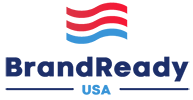International companies looking hoping to launch their business in the United States quickly learn that there is a long list of “to dos” for successful market entry. Top of mind on this list are things like: research into market structure and opportunity, securing funding for expansion, planning for US offices and distribution networks, and hiring good legal counsel to keep things on track.
However, there is one mission-critical activity not included on the list above that is often neglected by companies dreaming of making it big in the US – developing a powerful brand value proposition…one that has enough pizzazz to capture attention, build interest, and drive sales.
Read on to learn what you should know about building your brand for US market entry.
What Is Brand Building?
Experts trace the origins of the word “brand” back to Old Norse and its original meaning – a piece of burning wood. By the 17th century it had taken on the meaning of an “ownership mark” commonly used on livestock. But modern product branding practice, as we think of it now, emerged in the 19th century when companies like Campbell’s, Coca Cola and Juicy Fruit (gum) pioneered techniques for humanizing their mass-produced products with highly recognizable trade-marks and packaging.
The reason these advances were so important was that, for the first time, product marketers were learning how to take mass-produced commodities and transform them in the consumer mind into a more personalized product from a company they felt they knew and could trust.
This is the foundation for all successful branding-building – taking what is essentially a mass-produced commodity and transforming it from a generic, no-name product into a familiar, trusted, and differentiated solution that you are comfortable bringing into your home or office.
Why Brand Building Is Important
Here’s the deal – when you commit to building a clear & compelling brand value proposition you put yourself on the path to achieving a new level of customer familiarity and trust that, in turn, can inspire product trial, purchase, loyalty, and business growth.
A great example of this is Michelin. In the US, this tire company has been hammering away at core messaging around their value proposition of superior quality and family safety since at least 1990. Thanks to this consistent messaging – and the premium quality that supports it – they are now the top rated tire manufacturer in the US (Consumer Reports), ranked #1 for passenger tire satisfaction (J.D. Power), and boast top-tier unit/$ sales figures year after year – $9.2 billion in US for 2017.
But you may ask – why is brand building important for a smaller company that is just getting started in a foreign marketplace? Here’s a quick run-down of key benefits that a commitment to brand building will provide for companies entering the US market for the first time:
- Reference point – your brand can become a powerful visual reference point that will help potential customers recognize & remember your product in a cluttered marketplace
- Mark of distinction – your brand and the unique tapestry of ideas & positive imagery associated with it will differentiate you from competitors and highlight your superiority
- Sign of credibility – your prime prospects – B2B or B2C – are used to/expect high-quality brand messaging. Without it, you risk being viewed as amateurish and/or lacking in credibility
- Promise of value – over time your brand will become a powerful signal of the positive benefits, or value proposition, your product delivers.
Net – by committing to structured brand building efforts as part of your US market entry, you will be establishing a clear understanding among prospective customers & partners of your unique value proposition that will provide a foundation for driving sales, loyalty & customer evangelism!
The End-Game – Inspiring Key Audiences
Every business looking to make it in the USA should carefully evaluate their key sales targets and, in turn, develop strategies to address their specific needs. However, it is also appropriate to point out that, for the typical company considering US market entry, there are 3 high-level audiences that should be the focus for brand building efforts.
- Economic Buyers:
- Economic buyers are business audiences looking for some kind of economic gain. Their key concern is that your business model will help them make money – be that through assurance of reduced costs, improving revenues, business growth, increases in market valuation, or all of the above. This group may include investors, bankers, and C-level executives in US-based companies who are potential partners or customers.
- A powerful, well-executed brand message will inspire these audiences to do business with you for the following reasons:
- It helps them better understand your business model
- It explains how your product values will inspire customers
- It increases the likelihood (in their minds) your product will sell
- It signals that you have done your homework, and are well-positioned to succeed.
- End Users:
- This audience – usually described as ”customers” (B2B) or “consumers” (B2C) – is distinguished by the fact they are going to use your product themselves, or are answerable to others who will be using it.
- Their main concerns relate to the quality and functionality of product performance over time and that, if there are problems, they can be easily fixed. This group includes mid-level business managers who purchase your product to drive business performance, or consumer audiences who buy your product to satisfy personal needs.
- A powerful, well-executed brand message will inspire these audiences to do business with you for the following reasons:
- It draws their attention in a cluttered competitive market
- It clearly explains your product attributes and benefits
- It brings to life how your product solves their problem
- It helps establish feelings of familiarity & trust – reducing barriers to trial
- It lends creditability for your offering online, in-store, or in sales meetings
- It can suggest key functional/emotional end-benefits that drive desire and sales.
- Your Sales Team!
- Let’s face it – your success in breaking into US markets often depends on the ability of your sales teams to inspire US audiences and then close the deal, not just once but many times over.
- Whoever is appointed to “lead the charge” on US sales – this person will likely be aware of the need for critical tools like a strong “lead” pipeline, well-articulated sales collateral, product demonstrations, trade show opportunities, and the like. However, in my experience, one key component of the sales toolkit is often neglected – a clearly articulated brand value proposition, one that is consistently applied across sales touch-points like your website, sales sheets, pitch decks, sales presentations, or even your “elevator speech”.
- Building a powerful, well-executed brand message is important, not only as a tool to inspire potential customers, but also as a secret weapon for your sales team. In essence it can act as an invisible coach, providing them a prepared script (in natural American English) that can guide confident & highly eloquent delivery of key sales messages.
- Here’s the list of reasons that a powerful, well-executed brand message will help your sales team succeed:
- It provides guidelines on how to rapidly explain your core value proposition
- It guides consistent communication of key attributes and benefits
- It shows the team how to position the product as solving key problems
- It provides a “talk track” that lets the team speak in natural English
- It builds team confidence on how to bring the product story to life
- It signals sophistication and creditability to customer & prospect audiences
- It serves as a “stump speech” that can be delivered consistently over time…
such repetition is known to breed enhanced communication and believability!
Moral of This Story
The #1 take-away here, of course, is all about the utility of developing of a powerful, well-articulated brand value proposition to guide your US market entry efforts. Don’t hesitate to set aside sufficient budget for this activity. It is not overly expensive, and you’ll find it is worth every penny.
If you buy into the value of brand building, you will find that it not only helps drive customer purchasing, but also provides guidelines that will help your sales team operate at peak performance.
_________________________
Dave Nemiah is Managing Partner at BrandReady USA, a Connecticut-based research & strategy consulting firm that specializes in helping companies seeking to enter the US marketplace. In recently years, he has focused on helping Finnish companies clarify their brand strategy as a strategic lever for business development.

